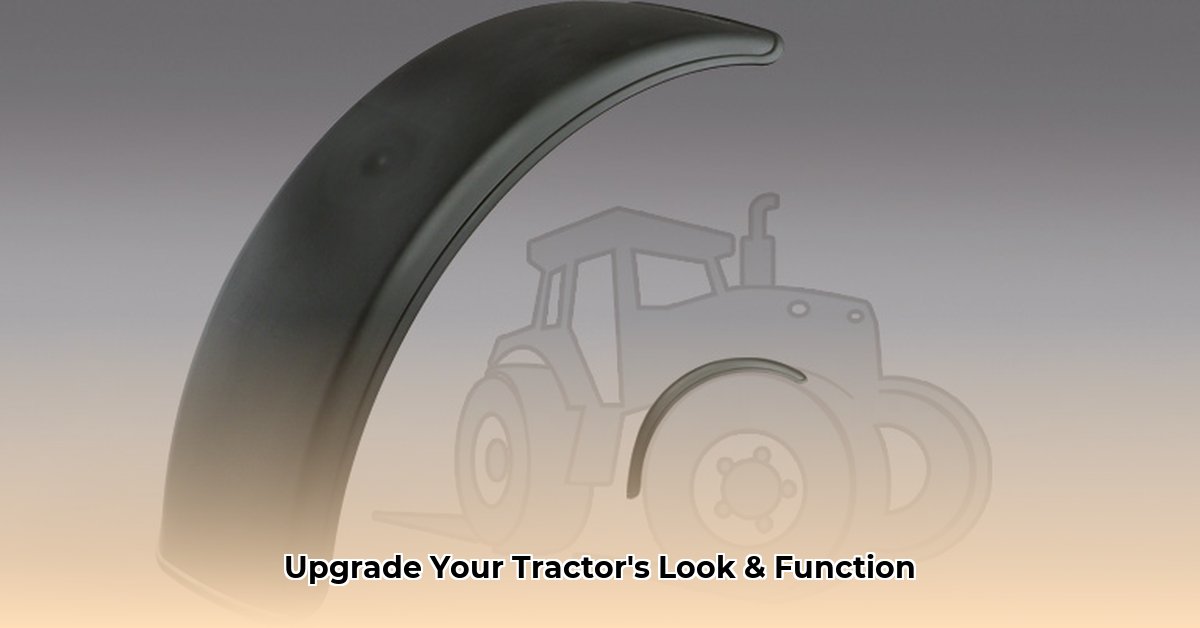
Tractor front fenders might seem like a minor detail, but they play a crucial role in protecting your tractor, your crops, and even your own safety. This comprehensive guide will help you navigate the complexities of choosing, installing, and maintaining the right fenders for your needs. From understanding different fender types and materials to troubleshooting compatibility issues, we've got you covered. For more on tractor front attachments, check out this helpful resource: tractor front attachments.
Choosing the Right Tractor Front Fenders: A Perfect Fit is Key
Selecting the ideal tractor front fenders involves several key considerations, all designed to ensure optimal performance and longevity. The first step is identifying your tractor's make and model. This information, readily available in your owner's manual or from your local dealer, is essential for ensuring a proper fit. Think of it like choosing shoes – the wrong size causes problems! Knowing your tractor's axle type (e.g., ZF, Carraro MFWD) is equally critical for accurate fender selection.
Next, consider your tractor's typical workload. Heavy-duty applications demand robust, durable fenders capable of withstanding significant impacts. Lighter tasks might permit a more economical option. Finding the right balance between durability and cost is key.
Finally, the material of your fenders impacts both their durability and cost. Common materials include:
Steel: Strong, relatively inexpensive, and widely available. However, steel is susceptible to rust. Regular maintenance is vital for long-term use.
Polymer (e.g., Polypropylene): Lightweight, corrosion-resistant, and often more aesthetically pleasing. Polymers can be more expensive initially, but their resistance to rust and reduced maintenance can offset this initial cost.
Here's a comparison highlighting the pros and cons:
| Material | Pros | Cons |
|---|---|---|
| Steel | Strong, durable, relatively inexpensive, readily available | Prone to rust, heavier than other materials |
| Polymer | Lightweight, corrosion-resistant, durable, often sleek look | Can be more expensive, might crack under extreme stress |
Installing Your New Fenders: A Step-by-Step Process
Installing tractor fenders is a straightforward process when approached systematically. However, correct installation is crucial for both function and safety. Always consult the manufacturer's instructions for your specific fender model. These instructions will provide valuable details and ensure the best fit. Here's a general guideline:
Step 1: Preparation: Gather the necessary tools (typically wrenches, bolts, and possibly a drill). Thoroughly clean the mounting area on your tractor to ensure a secure and corrosion-resistant fit.
Step 2: Precise Alignment: Carefully align the fenders with the mounting points on your tractor, ensuring a snug and even fit. Take your time; this is critical for proper function and aesthetics.
Step 3: Secure Attachment: Use the provided bolts and hardware to firmly attach the fenders. Tighten securely, but avoid over-tightening, which can damage the fenders.
Step 4: Final Inspection: Conduct a thorough inspection, checking alignment, stability, and clearance with all moving tractor parts.
Maintaining Your Tractor Front Fenders: Proactive Care for Longevity
Regular maintenance is essential for extending the lifespan of your tractor fenders. This involves simple actions that can significantly prevent damage:
Regular Cleaning: Periodically clean your fenders to remove mud, debris, dirt, and grime. This is particularly important after operating in wet or muddy conditions. Preventing buildup minimizes corrosion and keeps the fenders looking their best.
Regular Inspections: Frequently inspect your fenders for any signs of damage, such as cracks, bends, or impact marks. Addressing minor issues promptly prevents them from escalating into more significant problems.
Lubrication (When Applicable): Some fender designs include moving parts. If your fenders do, regular lubrication reduces friction and wear, significantly increasing their lifespan. Check your owner's manual for lubrication guidance.
Addressing Compatibility Issues: Troubleshooting for a Perfect Fit
Finding the right fenders isn't always a straightforward process because there's a lack of standardization across tractor brands and models. Always double check the dimensions of the proposed fenders against the measurements of your tractor. If you're unsure about compatibility, contact the supplier directly; it is better to spend time asking questions now than to deal with incompatibility later.
The Future of Tractor Front Fenders: Innovations on the Horizon
The agricultural industry is constantly seeking improvements in efficiency and sustainability. Conversations about standardizing mounting points for tractor fenders are underway, which will greatly simplify the process of replacing or upgrading fenders. Additionally, research explores the use of more environmentally friendly and durable materials in fender manufacturing, promoting sustainability and enhancing performance.
Three Pivotal Points to Remember:
- Proper fender selection protects your tractor and enhances its lifespan.
- Regular maintenance significantly extends the operational life of your fenders.
- Addressing compatibility issues early avoids costly and time-consuming later problems.
This guide provides a holistic approach to tractor front fender selection and maintenance. By adhering to these practices, you can ensure your tractor remains protected and operational while minimizing maintenance costs.